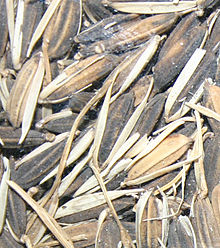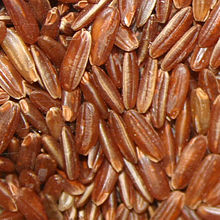Khác biệt giữa bản sửa đổi của “Ngũ cốc nguyên cám”
Đã cứu 0 nguồn và đánh dấu 1 nguồn là hỏng.) #IABot (v2.0.8 |
nKhông có tóm lược sửa đổi Thẻ: Trình soạn thảo mã nguồn 2017 |
||
| Dòng 1: | Dòng 1: | ||
[[Hình:Wheat-kernel nutrition.svg|350px|right]] |
[[Hình:Wheat-kernel nutrition.svg|350px|right]] |
||
'''Ngũ cốc nguyên cám''' (''ngũ cốc nguyên hạt'', ''ngũ cốc nguyên chất'', ''ngũ cốc toàn phần'') là một loại hạt của bất kỳ loại ngũ cốc và giả ngũ cốc nào có chứa nội nhũ, mầm và cám, trái ngược với các loại ngũ cốc tinh chế, chỉ giữ lại nội nhũ.<ref name=HEALTHGRAIN2013>{{chú thích web|url=https://www.healthgrain.org/sites/healthgrain.org/files/page/7/Healthgrain_Consortium_Whole_Grain_definition_2013-12.pdf|title=Whole grain definition|author=European Commission in the Communities 6th Framework Programme, Integrated Project HEALTHGRAIN|date=2013|accessdate=ngày 3 tháng 6 năm 2017}}{{Liên kết hỏng|date=2021-05-15 |bot=InternetArchiveBot }}</ref><ref name=AACCwholegrain>{{chú thích web|url=http://www.aaccnet.org/initiatives/definitions/Pages/WholeGrain.aspx|title=Whole Grains|publisher=[[American Association of Cereal Chemists|AACC]]|accessdate=ngày 3 tháng 6 năm 2017}}</ref><ref name=AACC2013>{{cite journal|url=http://www.aaccnet.org/publications/plexus/cfwplexus/library/books/Documents/WholeGrainsSummit2012/CPLEX-2013-1001-08B.pdf|title=Whole Grain Definition: New Perspectives for Inclusion of Grains and Processing but not for Analysis|journal=Cfw Plexus|last=van der Kamp|first=JW|date=2013|doi=10.1094/CPLEX-2013-1001-08B|accessdate=ngày 3 tháng 6 năm 2017}}</ref> |
'''Ngũ cốc nguyên cám''' (''ngũ cốc nguyên hạt'', ''ngũ cốc nguyên chất'', ''ngũ cốc toàn phần'') là một loại hạt của bất kỳ loại [[ngũ cốc]] và giả ngũ cốc nào có chứa [[nội nhũ]], [[Mầm ngũ cốc|mầm]] và [[cám]], trái ngược với các loại [[ngũ cốc tinh chế]], chỉ giữ lại nội nhũ.<ref name=HEALTHGRAIN2013>{{chú thích web|url=https://www.healthgrain.org/sites/healthgrain.org/files/page/7/Healthgrain_Consortium_Whole_Grain_definition_2013-12.pdf|title=Whole grain definition|author=European Commission in the Communities 6th Framework Programme, Integrated Project HEALTHGRAIN|date=2013|accessdate=ngày 3 tháng 6 năm 2017}}{{Liên kết hỏng|date=2021-05-15 |bot=InternetArchiveBot }}</ref><ref name=AACCwholegrain>{{chú thích web|url=http://www.aaccnet.org/initiatives/definitions/Pages/WholeGrain.aspx|title=Whole Grains|publisher=[[American Association of Cereal Chemists|AACC]]|accessdate=ngày 3 tháng 6 năm 2017}}</ref><ref name=AACC2013>{{cite journal|url=http://www.aaccnet.org/publications/plexus/cfwplexus/library/books/Documents/WholeGrainsSummit2012/CPLEX-2013-1001-08B.pdf|title=Whole Grain Definition: New Perspectives for Inclusion of Grains and Processing but not for Analysis|journal=Cfw Plexus|last=van der Kamp|first=JW|date=2013|doi=10.1094/CPLEX-2013-1001-08B|accessdate=ngày 3 tháng 6 năm 2017}}</ref> |
||
Là một phần của chế độ ăn uống lành mạnh nói chung, tiêu thụ ngũ cốc nguyên hạt có tác động đến nguy cơ mắc một số bệnh thấp hơn.<ref name=Heart2016 /> Ngũ cốc nguyên hạt là nguồn cung cấp carbohydrate, nhiều chất dinh dưỡng và chất xơ.<ref name="eufic" /><ref name="usda1" /><ref name="usda2" /> Protein ngũ cốc có chất lượng thấp, do thiếu hụt [[axit amin]] thiết yếu, chủ yếu là [[lysine]].<ref name="UNESCO-EOLSS">{{chú thích web|url=http://www.eolss.net/sample-chapters/c10/E5-21-04-04.pdf|title=Impacts of agriculture on human health and nutrition – Vol. II - Improving the Protein Content and Quality of Temperate Cereals: Wheat, Barley and Rye|last=Shewry|first=PR|publisher=UNESCO - [[Encyclopedia of Life Support Systems|Encyclopedia Life Support Systems (UNESCO-EOLSS)]]|accessdate=ngày 2 tháng 6 năm 2017|quote=When compared with the WHO requirements of essential amino acids for humans, wheat, barley and rye are seen to be deficient in lysine, with threonine being the second limiting amino acid (Table 1).}}</ref><ref name=FAOcerealsquality>{{chú thích web|url=http://www.fao.org/docrep/x2184e/x2184e05.htm|title=Nutritional quality of cereals|publisher=Food and Agriculture Organization of the United Nations|accessdate=ngày 1 tháng 6 năm 2017}}</ref> Ngược lại, protein của nhóm giả ngũ cốc (pseudocereal) có giá trị dinh dưỡng cao.<ref name=FAOproperties2015>{{cite journal|url=http://agris.fao.org/agris-search/search.do;jsessionid=0E53708D8FB5B35BCA1BB4BBE8D7DDFB?request_locale=ru&recordID=US201600108750&query=&sourceQuery=&sortField=&sortOrder=&agrovocString=&advQuery=¢erString=&enableField=|title=Properties of extruded whole grain cereals and pseudocereals flours|journal=International Journal of Food Science & Technology|volume=50|issue=10|pages=2152–2159|authors=Robin F, Théoduloz C, Srichuwong S|date=2015|doi=10.1111/ijfs.12893|accessdate=ngày 3 tháng 6 năm 2017}}</ref><ref name=SaturniFerretti2010>{{cite journal| vauthors=Saturni L, Ferretti G, Bacchetti T| title=The gluten-free diet: safety and nutritional quality | journal=Nutrients | year= 2010 | volume= 2 | issue= 1 | pages= 16–34 | pmid=22253989 | doi=10.3390/nu2010016 | pmc=3257612 | type=Review }}</ref> |
Là một phần của chế độ ăn uống lành mạnh nói chung, tiêu thụ ngũ cốc nguyên hạt có tác động đến nguy cơ mắc một số bệnh thấp hơn.<ref name=Heart2016 /> Ngũ cốc nguyên hạt là nguồn cung cấp carbohydrate, nhiều chất dinh dưỡng và chất xơ.<ref name="eufic" /><ref name="usda1" /><ref name="usda2" /> Protein ngũ cốc có chất lượng thấp, do thiếu hụt [[axit amin]] thiết yếu, chủ yếu là [[lysine]].<ref name="UNESCO-EOLSS">{{chú thích web|url=http://www.eolss.net/sample-chapters/c10/E5-21-04-04.pdf|title=Impacts of agriculture on human health and nutrition – Vol. II - Improving the Protein Content and Quality of Temperate Cereals: Wheat, Barley and Rye|last=Shewry|first=PR|publisher=UNESCO - [[Encyclopedia of Life Support Systems|Encyclopedia Life Support Systems (UNESCO-EOLSS)]]|accessdate=ngày 2 tháng 6 năm 2017|quote=When compared with the WHO requirements of essential amino acids for humans, wheat, barley and rye are seen to be deficient in lysine, with threonine being the second limiting amino acid (Table 1).}}</ref><ref name=FAOcerealsquality>{{chú thích web|url=http://www.fao.org/docrep/x2184e/x2184e05.htm|title=Nutritional quality of cereals|publisher=Food and Agriculture Organization of the United Nations|accessdate=ngày 1 tháng 6 năm 2017}}</ref> Ngược lại, protein của nhóm giả ngũ cốc (pseudocereal) có giá trị dinh dưỡng cao.<ref name=FAOproperties2015>{{cite journal|url=http://agris.fao.org/agris-search/search.do;jsessionid=0E53708D8FB5B35BCA1BB4BBE8D7DDFB?request_locale=ru&recordID=US201600108750&query=&sourceQuery=&sortField=&sortOrder=&agrovocString=&advQuery=¢erString=&enableField=|title=Properties of extruded whole grain cereals and pseudocereals flours|journal=International Journal of Food Science & Technology|volume=50|issue=10|pages=2152–2159|authors=Robin F, Théoduloz C, Srichuwong S|date=2015|doi=10.1111/ijfs.12893|accessdate=ngày 3 tháng 6 năm 2017}}</ref><ref name=SaturniFerretti2010>{{cite journal| vauthors=Saturni L, Ferretti G, Bacchetti T| title=The gluten-free diet: safety and nutritional quality | journal=Nutrients | year= 2010 | volume= 2 | issue= 1 | pages= 16–34 | pmid=22253989 | doi=10.3390/nu2010016 | pmc=3257612 | type=Review }}</ref> |
||
Phiên bản lúc 10:36, ngày 31 tháng 5 năm 2021

Ngũ cốc nguyên cám (ngũ cốc nguyên hạt, ngũ cốc nguyên chất, ngũ cốc toàn phần) là một loại hạt của bất kỳ loại ngũ cốc và giả ngũ cốc nào có chứa nội nhũ, mầm và cám, trái ngược với các loại ngũ cốc tinh chế, chỉ giữ lại nội nhũ.[1][2][3]
Là một phần của chế độ ăn uống lành mạnh nói chung, tiêu thụ ngũ cốc nguyên hạt có tác động đến nguy cơ mắc một số bệnh thấp hơn.[4] Ngũ cốc nguyên hạt là nguồn cung cấp carbohydrate, nhiều chất dinh dưỡng và chất xơ.[5][6][7] Protein ngũ cốc có chất lượng thấp, do thiếu hụt axit amin thiết yếu, chủ yếu là lysine.[8][9] Ngược lại, protein của nhóm giả ngũ cốc (pseudocereal) có giá trị dinh dưỡng cao.[10][11]
Đối với một phần nhỏ của dân số nói chung, bị dị ứng với gluten – protein có trong lúa mì và các loại ngũ cốc liên quan[12] – có thể gây ra bệnh coeliac, mẫn cảm gluten không do bệnh coeliac, chứng mất điều hòa tiểu não (gluten ataxia) và viêm da do herpetiformis (dermatitis herpetiformis).[13]
Các loại giống



Các nguồn cung cấp ngũ cốc nguyên hạt bao gồm:[1][11]
Ngũ cốc
- Lúa mì (ngũ cốc cổ xưa spelt, emmer, farro einkorn, lúa mì Khorasan, durum)
- Gạo (đen, đỏ và các loại gạo có màu khác)
- Lúa mạch (vỏ hoặc tách vỏ nhưng không xay)
- Ngô
- Lúa mạch đen
- Yến mạch (gồm yến mạch không có vỏ hoặc trần)
Nhóm ngũ cốc phụ
- Kê
- Chi Cao lương
- Eragrostis tef
- Triticale
- Cỏ hoàng yến
- Ý dĩ
- Hạt Fonio, fonio đen, hạt kê châu Á
Giả ngũ cốc
- Chi Dền
- Mạch ba góc, Mạch đắng
- Diêm mạch
- Gạo dại
Góc độ dinh dưỡng
Ngũ cốc nguyên hạt giúp phòng ngừa bệnh tiểu đường, chất xơ từ ngũ cốc nguyên hạt giúp ngừa hội chứng chuyển hóa. Ăn trên 3 bữa ngũ cốc nguyên hạt một ngày có thể giúp làm giảm đáng kể nguy cơ mắc bệnh tiểu đường và những loại ngũ cốc giàu chất xơ đem lại hiệu quả cao nhất. một chế độ dinh dưỡng giàu ngũ cốc nguyên hạt giúp ngăn ngừa hội chứng chuyển hóa, bao gồm các yếu tố tiềm ẩn dẫn đến bệnh tiểu đường type 2 và các bệnh tim mạch.[14]
Chú thích
- ^ a b European Commission in the Communities 6th Framework Programme, Integrated Project HEALTHGRAIN (2013). “Whole grain definition” (PDF). Truy cập ngày 3 tháng 6 năm 2017.[liên kết hỏng]
- ^ “Whole Grains”. AACC. Truy cập ngày 3 tháng 6 năm 2017.
- ^ van der Kamp, JW (2013). “Whole Grain Definition: New Perspectives for Inclusion of Grains and Processing but not for Analysis” (PDF). Cfw Plexus. doi:10.1094/CPLEX-2013-1001-08B. Truy cập ngày 3 tháng 6 năm 2017.
- ^ Lỗi chú thích: Thẻ
<ref>sai; không có nội dung trong thẻ ref có tênHeart2016 - ^ Lỗi chú thích: Thẻ
<ref>sai; không có nội dung trong thẻ ref có têneufic - ^ Lỗi chú thích: Thẻ
<ref>sai; không có nội dung trong thẻ ref có tênusda1 - ^ Lỗi chú thích: Thẻ
<ref>sai; không có nội dung trong thẻ ref có tênusda2 - ^ Shewry, PR. “Impacts of agriculture on human health and nutrition – Vol. II - Improving the Protein Content and Quality of Temperate Cereals: Wheat, Barley and Rye” (PDF). UNESCO - Encyclopedia Life Support Systems (UNESCO-EOLSS). Truy cập ngày 2 tháng 6 năm 2017.
When compared with the WHO requirements of essential amino acids for humans, wheat, barley and rye are seen to be deficient in lysine, with threonine being the second limiting amino acid (Table 1).
- ^ “Nutritional quality of cereals”. Food and Agriculture Organization of the United Nations. Truy cập ngày 1 tháng 6 năm 2017.
- ^ Robin F, Théoduloz C, Srichuwong S (2015). “Properties of extruded whole grain cereals and pseudocereals flours”. International Journal of Food Science & Technology. 50 (10): 2152–2159. doi:10.1111/ijfs.12893. Truy cập ngày 3 tháng 6 năm 2017.Quản lý CS1: sử dụng tham số tác giả (liên kết)
- ^ a b Saturni L, Ferretti G, Bacchetti T (2010). “The gluten-free diet: safety and nutritional quality”. Nutrients (Review). 2 (1): 16–34. doi:10.3390/nu2010016. PMC 3257612. PMID 22253989.
- ^ Lỗi chú thích: Thẻ
<ref>sai; không có nội dung trong thẻ ref có tênBiesiekierski2017 - ^ Ludvigsson JF, Leffler DA, Bai JC, Biagi F, Fasano A, Green PH, Hadjivassiliou M, Kaukinen K, Kelly CP, Leonard JN, Lundin KE, Murray JA, Sanders DS, Walker MM, Zingone F, Ciacci C (tháng 1 năm 2013). “The Oslo definitions for coeliac disease and related terms”. Gut. 62 (1): 43–52. doi:10.1136/gutjnl-2011-301346. PMC 3440559. PMID 22345659.
- ^ “Ngũ cốc nguyên hạt giúp phòng ngừa bệnh tiểu đường - VnExpress Đời sống”. VnExpress - Tin nhanh Việt Nam. Truy cập 7 tháng 6 năm 2014.
